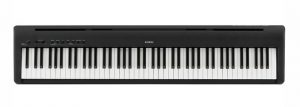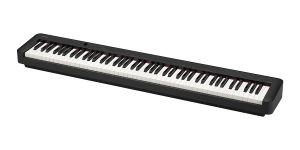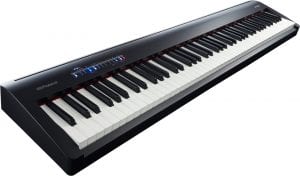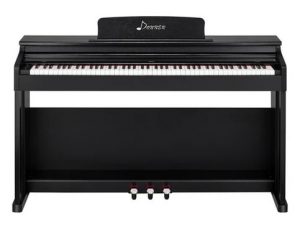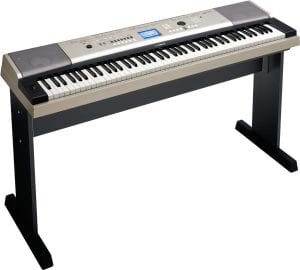If you have made up your mind to buy the right digital piano, then it is important that you go through a number of verified sites and portals to choose the best piece of piano. Making the final decision about buying an ideal piano can be an intimidating task. But to your surprise, you can get the best digital pianos, that have the same feature as an acoustic piano at a cost that is less than $700. All of the leading piano brands such as Yamaha, Casio, Roland, etc., offer pianos at this amazing cost.
But before choosing to buy one of the best digital pianos under $700, one has to keep a close watch on why they are buying the piano for. Are you buying to learn the instrument, for live gigs, for recording at your home, or in a studio? Or for stage performances? Also. keep the skill level in mind and choose pianos accordingly, as most of them have built-in lessons and have some advanced features for advanced professionals.

Quick Summary: Best Digital Pianos Under $700
Check out: Best Budget Digital Pianos Under $500
Top 8 Best Digital Pianos Under $700
Digital pianos are completely different musical instruments that sample acoustic pianos and mimic their sound. We have discussed the top 8 best digital pianos under $700 here to help our readers in their buying choice, to help them get the best instrument, and to feed their music fervor.
1. Yamaha P125 Digital Piano – Best Overall
This is one of the excellent digital pianos under $700, to offer an excellent piano-playing experience at an affordable cost. These digital pianos also carry a number of great features that add value to every single penny of money spent on them. This piano is of the highest quality plastic and is available in white and black colors. It is portable, you can take it to consorts, for parties, and even to school and college competitions and stage shows.
There are special buttons for different sound sections such as the bass, E.piano, strings, organ, piano, etc., and there are special buttons for rhythms, recording, metronome features, etc.
The Keys of the Yamaha P125 feature a matte finish, which makes them the best piano for high-humid situations. The keys can alter the volume and timbre of the sound, depending on how hard or soft, you play its keys.
The Yamaha P125 has 24 built-in tones. Every time you strike the keys, you listen to the high-quality pure CF sound engine of the CFIIIS concert grand. The P-125 features a newly redesigned speaker system.
It has four speakers, two on either side. We can record the chords in MIDI format and transfer the same to the PC. The USB to-host jack connects the piano to a computer to exchange MIDI data and songs.
What’s Best in Yamaha P125?
- The piano has the best quality speakers and sound engine.
- This piano reproduces the realistic tone of the CFIIIS grand acoustic piano.
- Compact and affordable piano with ample accessories.
What’s Lacking in Yamaha P125?
- The piano does not come with a stand but comes with a music rest feature.
- There are limited sound effects on this piano.
2. Kawai ES110 Stage Digital Piano – Runner Up
| Features | Rating |
| Performance and sounds | 9.4 |
| Connectivity | 9.1 |
| Build Quality | 9.1 |
| For Beginners | 9.3 |
| Value for money | 9.4 |
This is an excellent digital piano that features an excellent graded hammer action keyboard and an 88-note piano sampling feature to render a tremendous piano experience for the pianist. This piano is capable of exhibiting an exceptional piano experience and makes use of the acclaimed harmonic imaging sound technology. The piano also features an 88-key sampling, so as to create an impressive piano sound. The best feature of this piano is its feel. Its responsive hammer compact weighted key action and an 88-note graded hammer action offer exceptional feel and sensitivity to the piano players.
The Kawai ES110 features a MIDI jack that is great for connecting with other musical instruments, computers, and gadgets. Its audio line outputs connect with an external speaker system or audio recorder. There are two headphone jacks that allow a teacher, partner, or parent to listen in. Apart from the standard MIDI ports, the new ES110 also bags on its integrated Bluetooth MIDI technology, allowing the digital piano to communicate with other smart devices wirelessly.
The ES-110 offers an easy-to-use 3-song built-in recorder that is ideal for self-evaluation and for creating masterpieces. Along with the digital piano, players also get a pair of super comfortable and lightweight Samsung stereo headphones.
What’s Best in Kawai ES110?
- This piano features exceptional harmonic imaging sound technology.
- The piano has a responsive hammer action keyboard with an 88-key piano sampling.
- It features dual and split keyboard modes and features a built-in stereo speaker system.
- The piano is shipped with an optional matching stand and pedal assembly.
What’s Lacking in Kawai ES110?
- A very heavy keyboard that is not easy to carry.
3. Casio Privia PX-S1000 Digital Piano – Editor’s Choice
The Casio Privia PX-S1000 88 key digital piano features a sustain pedal, AC adapter, cushion bench, lightweight adjusting stand, and a full-size sustain pedal. The PX-S1000 is the perfect combination of innovation and playability that makes it something special more than ordinary pianos. The PX-S1000 belongs to the Slim category of the Casio series and we should accept that this piano is seriously slim and compact.
The controls on the piano make use of capacitive technology and the pianist has to touch them with bare hands to activate them. And unlike most other digital and stage pianos, the S1000 can also run on 6 AA-size batteries.
The Casio Previa makes use of the Tri-sensor hammer action keyboard, our PX-S1000 makes use of smart-scaled hammer action keys. The keyboard has five levels of touch sensitivity spanning from light to heavy, along with an Off option, thus the harder you hit the key, the louder its sound.
The piano sounds are sampled from the concert grand piano with excellent tones, sounding similar to the grand acoustic pianos along with the jazz pianos and the mellow grand pianos. This Casio has two built-in 8W speakers with excellent amplification, good enough to fill a medium-sized room with awesome music.
What’s Best in Casio Privia PX-S1000?
- Features the best connectivity features for a portable piano of its class.
- It is possible to adjust a number of parameters in this piano to craft unique music pieces.
- Features Bluetooth connectivity
- Compact piano to carry for stage shows
What’s Lacking in Casio Privia PX-S1000?
- The keys could be quite hard on the fingers
- There is no display screen
4. Casio CDP-S150 Digital Piano – Great Home Piano Under $700
| Features | Rating |
| Performance and sounds | 9.3 |
| Connectivity | 9.1 |
| Build Quality | 8.9 |
| For Beginners | 9.5 |
| Value for money | 9.4 |
The Casio CDP S-150 88-key digital piano is portable, realistic, and is very comfortable for playing some high-quality music. This is a perfect piano for students and is shipped with a sustain pedal and a music rest. This piano is extremely compact and lightweight and it weighs only 23.1 lbs. The piano is capable of functioning on both its included power supply and on its AA-size batteries. The CDP S-150 is the perfect entry-level piano for anybody looking for a portable and quality keyboard experience.
It comes in black color with a decent look and its outer surface has a matte finish, adding to its elegance. The CDP-S150 has the simplest control panel and it is pretty simple to navigate so that even children will feel comfortable using them. These keys tend to have shorter pivot lengths so as to decrease the width of the piano. They do carry key sensors so as to track your keypresses and thus are great for practice and concert playing.
The sounds of this piano are sampled from some concert grand pianos and undoubtedly sound clean and excellent. The CDP-S150 has a maximum polyphony of 64 notes, good enough to cover all song types be it classical or modern ballads. The piano also comes with two built-in effects, the Chorus, and the Reverb. The CDP S series has some basic connectivity features, just enough for a budget piano of its range.
What’s Best in Casio CDP-S150?
- The damper pedal jack helps to play in different tone variations.
- It has a 3.5 mm mini-jack that helps to connect with an amplifier and an external PA system.
- Has the best set of accessories such as a music rest, power adapter, and damper pedal.
- Features an excellent build and is a good bet for the cost spent.
What’s Lacking in Casio CDP-S150?
- The keys have less pivot length and can be hard to press.
- No duo mode or split mode is available.
Must Check: Best Home Digital Pianos
5. Roland FP-30 – Great Intermediate Keyboard Under $700
| Features | Rating |
| Performance and sounds | 9.5 |
| Lightweight | 9.1 |
| Connectivity | 9.1 |
| Build Quality | 9.3 |
| Value for money | 9.5 |
If you are looking for the nuances of an acoustic piano in a small and portable footprint and doubled with stereo speakers and power amplifiers, then the Roland digital keyboard should be your destination and it is also available at an affordable cost. Despite being the piano on a budget, I loved the fact that this 88-note standard keyboard rendered an authentic piano touch for maximum expression. Its powerful amplifiers and stereo speakers are show stoppers. The music when played through this piano without any doubt reaches the maximum expression.
The keyboard has 88 keys and they are graded, but unlike other budget pianos, the keys do not emit any sound when played and render a very quiet keyboard action. There is also a headphone jack to listen to your tunes, and thus, you can play in solidarity, without having to disturb others. A matching stand comes as an option and its three-pedal unit offers this piano a modern classic look and enhanced functionality. It is also compatible with some sheet music apps for a hands-free page-turning experience.
This piano doesn’t come in a furniture model and is extremely compact and lightweight. You can move this piano easily for stage shows and piano lessons. We can also broaden the musical experience with the dual and the split modes along with an option to choose a range of non-piano sounds such as the voices, drums, strings, organs, and a lot more.
What’s Best in Roland FP-30?
- There is a twin piano mode that is ideal for piano lessons.
- Possible to connect the USB memory to save songs that are captured in the SMF recorder.
- Its powerful speakers render an impressive surround sound.
What’s Lacking in Roland FP-30?
- The piano is a little heavier than expected.
- The sustain pedal could have been better.
6. Korg B2 Digital Piano – Amazing Choice for Beginners
This is a fantastic digital piano that all musicians appreciate and its diverse digital sounds are the ones that great pianos appreciate. The B2 seems to be packed with the best sounds and samples the sounds from legendary grand pianos from all over the world. This can either be a piano for beginners and it can appeal to advanced players as well, who are looking for something comfortable to play good music.
The sound engine of this piano ensembles 12 carefully selected piano sounds and the keyboard without any doubt reproduces the touch of an acoustic piano. It is equipped with the touch of an acoustic piano and it features a generous software bundle for practicing some high-quality music. Functionality, simplicity, and convenience are the standards of this piano and it also includes a music rest to keep the music sheets and the mobile devices for playing.
This musical instrument makes use of a naturally weighted hammer action keyboard and this piano reproduces the same feel as that of a real acoustic piano. The low registers of this piano are heavier and the high registry is lighter. The key bed of this piano is highly sensitive and the keys respond to the nuances of fingertips. We can also use a USB cable to connect the piano to the smartphone, computer, or tablet to play an external sound module.
What’s Best in Korg B2?
- The home speaker system of B2 can be of great help in enjoying high-quality music.
- Features a generous bundle of software to practice high-quality music
- Piano comes with a three-month premium plan for Skoove online piano lessons.
What’s Lacking in Korg B2?
- The keys are made of glossy plastic and are not simulated with ivory.
- The controls are also not intuitive.
7. Donner DDP-100 Digital Piano – Good for Beginners to Intermediates
This piano from Donner has been crafted with the ultimate aim to create new musical experiences and performances. Donner is committed to the creation of innovative and exceptional musical instruments that maintain very good quality and also serve as an inspiration for artists and creators. This piano features full-size hammer-action weighted keys that are capable of restoring the music of the original grand acoustic pianos and helps to cultivate one’s interest in the music.
This piano makes use of an AWM sampling technology that realistically restores the sound and music of an original grand piano. It is compatible with both the amplifier and the headphones and thus is capable of immersing a big room or stage with high-quality music.
All three pedals of this piano are great and help in stimulating the nuances of a grand acoustic piano. The unit also features an impressive sound quality and its AWM dynamic samples help in producing deeper and richer piano sounds.
We found that its 88-key keybed is weighted and is capable of restoring the sounds of the original grand piano. These keys are capable of training the ability of the users to distinguish sounds and develop innate musical sense and intonations. The piano sounds great with its standard speakers that are present under the main body of the piano. Two headphone jacks help to play and listen to music in solidarity.
What’s Best in Donner DDP-100?
- The piano is constructed of solid fiberboard that looks very realistic.
- Great piano for the price and occupies minimal space in the room
- Excellent piano for the money and it is also very great for beginners
What’s Lacking in Donner DDP-100?
- The accompaniment sounds such as the organ, strings, and harpsichord are missing in this piano.
- The piano sounds quite digital.
amazon link=”B003F2X13I” title=”8. Yamaha YPG535 Digital Piano[“] – Great Alternative for Intermediates
| Features | Rating |
| Performance and sounds | 9.6 |
| Connectivity | 9.2 |
| Portability | 8.5 |
| Easy to Assemble | 9.6 |
| Build Quality | 9.3 |
| Value for money | 9.6 |
The Yamaha YGP 535 is an excellent piano with several useful features and is available at an affordable cost of less than $700. This comes with an easy-to-use panel with a wealth of features that features a graded soft-touch action with different levels of resistance and a very high-resolution sound sample. The piano features 88-piano style keys with a graded soft-touch system and a 6-track sequencer to record one’s own music.
This is an excellent piano for those students who are starting their piano lessons. The music database of this piano offers 267 keyboard setups by sing title. The piano renders the best piano sounds in the industry and with a simple press, this portable grand piano resets the entire piano to a stereo-sample piano, which is perfect for practice.
The piano offers several realistic-sounding voices that include that of a flute, trumpet, saxes, etc. The piano offers a stunning variety of styles and voices and opens the world of opportunities for pianists.
We can simply create an orchestra with this piano by picking up the best music style. This portable grand piano comes with 30 built-in songs and comes with a CD-ROM for interactive lessons. You also get to connect the piano to the computer with the help of a USB, through which you can download more songs from the internet and use the Yamaha Education Suite to learn those songs as well.
What’s Best in Yamaha YPG535?
- Offers the industry’s best piano sounds.
- Connects easily with a computer
- Renders realistic sounding voices.
- The chord dictionary helps players play chords.
What’s Lacking in Yamaha YPG535?
- The keys are slightly weighted, and not as good as a regular piano.
- Doesn’t come with a music book stand.
Check out: Best Intermediates Digital Pianos
Are Digital Pianos Worth It?
Most of the time, yeah! As long as you get a digital piano that meets your requirements and ambitions, they are a worthwhile investment. It often entails getting a piano of greater caliber than you might if you bought an acoustic piano for a comparable price. In addition, it offers a number of features that are similar to those of an acoustic piano, such as classic sound and touch, as well as technology and possibilities that are not available with a digital piano. Because they are cheaper than traditional pianos, digital pianos are a favorite among new piano owners.
Digital pianos may cost as little as $2000 to $3000, as opposed to acoustic pianos, which start at roughly $5000. A digital piano’s key benefit is its adaptability. Digital pianos, as we have established, can produce hundreds of distinct piano sounds, as well as organ, synth, and harpsichord tones. This not only makes it simple to locate the ideal sound for a particular style or song but more vitally, it expands your creative options.
And for a musician, that’s the main focus! Another benefit that makes digital pianos increasingly appropriate for contemporary applications is their size. Real acoustic pianos are heavy and take up a lot of room, making them difficult to move around and store. This isn’t a problem if you have a big house or a studio. However, it can be for the majority of individuals.
Keep Your Piano Free Of Dust
Get a cotton cloth, soak it with some water when you feel the need to clean your keys, and then wipe them all down. You should be able to remove all of the residue and fingerprints by softly wiping them.
If a moist towel is ineffective, try a light soap or dishwashing detergent. A very little quantity should be applied to the cloth before softly rubbing the keys. Avoid immediately pouring soap or detergent on the keyboard! Avoid using any kind of cleaners or chemicals on the keys at all to prevent losing the unique smoothness that allows our fingertips to slide across them rather than adhering to them.
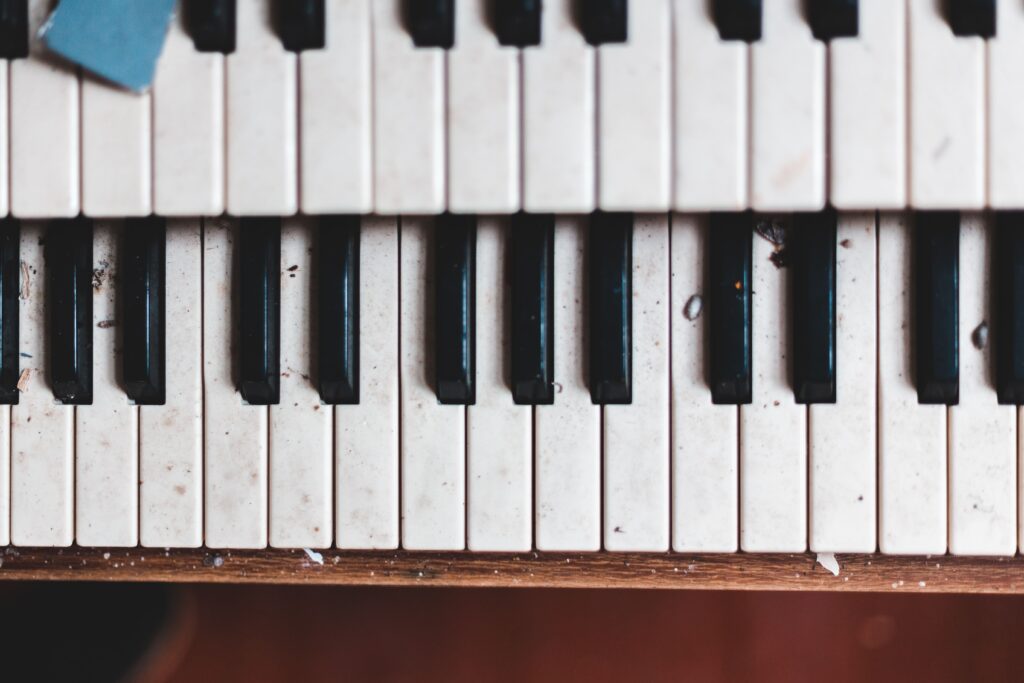
Again, a moist cloth works best to remove fingerprints off the outside casing, but if you must use a polish, make sure it is water-based and free of silicone.
Use one of the furniture brush nozzles on the end of your vacuum cleaner to sweep over the keys as a sneaky little trick. Use a gentle brush nozzle; avoid using a harsher one since it can scrape the surface.
Keep all liquids and beverages away from your priceless piano. Any damage from liquid or water to the piano’s internal mechanisms, including the movement of the keys, will cause the instrument to be irreparably damaged. Don’t even try it, then!
Move Your Piano Without Professional Help
- To prevent damage, put bubble wrap over the pedals and piano keys.
- Put the piano’s lid on and cover it with an old towel or a foam packing sheet. Use tape to hold the foam or cloth in place.
- Wrap the piano with moving blankets and tape them down once again. Ensure that the sides, back, and front of the piano are all covered with blankets.
- Using moving or ratchet straps, further secure the moving blankets.
- Prepare your group for the lift. To lift the instrument, you should have a person on at least two opposite sides. The dolly should be able to be moved beneath by a third person.
- As you lift, bend your knees to prevent damage.
- Move the piano through the house slowly. To lessen the chance of harm coming to the piano or the home, take more time traversing doors and corners.
- Ratchet straps should be used to secure the piano inside the vehicle.
- Have at minimum one person (more depending on the size of the piano) in front of the piano when unloading it from the truck for greater control.
Tune Your Piano To Be Beginner Friendly
- Make the space as peaceful and secluded as needed before tuning your piano: Turn off all appliances, especially those that generate humming noises, and shut the doors.
- Set up a light to properly see the workstation, take off any cabinet doors that may have been covering the piano strings (if any), and lightly dust the strings. Look for any damage to the piano pins and strings. Consult a specialist if the piano is seriously malfunctioning.
- Identify the strings that play middle C. Ancient pianos might only have two strings for the note, but most pianos have three for middle C (and many other notes in the middle of the keyboard). If your piano has three strings, use your rubber mutes to mute the outside strings, or if your piano has two strings, simply the left string.
- Use an electric tuner, to hear what note the tuner hears on the one unmuted string, and play the middle C (C4) piano key loudly and forcefully. Be prepared for a lot of flat notes as a piano often goes out of tune by becoming balanced as the tension on the string lessens.
- Choose the pin that the single string is coiled around, then carefully set the tuning lever’s head over that pin. To slightly loosen the pin, crank the lever counterclockwise. To slightly tighten the pin to a true center C, gently turn the lever clockwise. To prevent over-loosening or over-tightening, operate the pin gently and attempt to twist it as little as possible.
- The setting is a method used by expert piano tuners to fully tighten a pin and, ideally, help the string keep its tune for longer. A popular method of setting a pin is to use one last tightening stroke to bring it slightly above the pitch, followed by one gentle loosening action to reach the precise right pitch. Different tuners have various methods for doing this.
- Repeat the procedure for each center string in the notes from C4 to C5 once your middle C string is in tune. It’s time to “tune the unisons,” or tune the outside strings that play for each of the notes C4 to C5 since the center strings of each note are now in tune. Unmute the middle C’s left and center strings so you may tune a note to the string you’ve previously tuned when tuning the first unison.

- For this step, put the electronic piano tuner aside; tuning unisons by ear is more accurate. Play the note loudly and forcefully while keeping an ear out for a “beat” (also known as a warble, disharmony, or wah-wah-wah sound wave). Then, gently work the new string’s pin until the two strings ring out loudly and clearly together.
- For this step, put the electronic piano tuner aside; tuning unisons by ear is more accurate. Play the note loudly and forcefully while keeping an ear out for a “beat” Then, gently work the new string’s pin until the two strings ring out loudly and clearly together.
- Once the first string in the middle C unison is in tune, repeat the procedure for the other left strings in the notes C4 to C5, and then repeat the procedure once more for the right strings in the octave. Your piano should now have the full middle octave in tune. “Setting the temperament” is what this is.
- Start tuning a new octave (such as C5 to C6) by comparing each note with the tuned note you have in your temperament, using the temperament notes as your reference. Keep tuning one string at a time, utilizing your mutes to suppress the other strings until you’re ready to tune them (The bass strings may only have one string, however, the higher treble area of the keyboard should have three strings for every note.)
- Likewise, to pitch the unisons, tune the piano “to itself” (without an electronic tuner) for the most pleasing sound at this phase. To create superior fine-tuning, experts frequently use extra methods and theories at this step, such as major thirds, fourths, and fifths, the equal temperament model, inharmonicity, and hand stretching octaves.
What To Look For In Your Digital Piano?
If you have decided to buy a piano from the best brands, within your budget of $700, then you should look for the following features in your piano. $700 is no easy money and if your piano doesn’t carry the required features, then you end up losing in the deal. The best digital pianos from the best brands have the following features.
- Weighted Keys: Make sure that the digital piano that you invest in is able to mimic the feel and string consistency of an acoustic piano. If the keys are not weighted then there won’t be much depth in the music notes and we end up playing bland notes every time.
- Polyphony: Polyphony is the number of individual tones that the piano can create at a given time. The higher the number of polyphonies in the instrument, the more the number of complex sounds that the piano can create.
- Sensitivity to velocity: This is the measure of how best the piano responds to different finger pressures. If the finger press is harder, then the piano renders a strong sound, and vice versa.
- Voices: This is an indication of the different piano sounds that are available in the instrument. The more the number of voices, the better will be the quality of the music that is been created.
Considering these additional features in a piano is mandatory for seasoned musicians as they are making a long-term investment in the musical instrument and are looking forward to growing their passion for music with the instrument.
Must Check: Best Digital Pianos Under $1000
You Might Also Like
- Roland FP30X: Best Portable Digital Piano Review
- Korg D1: Best Digital Piano Review
- Top 6 Best Piano Learning Apps For Android & iOS
- Top 10 Best Piano Keyboard Stands for Standing
- Top 7 Best Piano Keyboard Stands
Conclusion
If you have made up your mind to buy a digital piano for $700, then it is always a good idea to make a checklist of items that you would require in the piano. Look for the quality of the keyboards, the polyphony, the number of instrument sounds and voices available on the keyboard, etc. We hope our guide helps you in picking up one of the best digital pianos under $700 from leading brands.
Frequently Asked Questions (FAQs)
1. How Does Dust Affect the Piano?
Dirty and dusty string windings won’t produce as brilliant of a tone as clean ones. Single-strand strings with rust won’t vibrate as effectively as those without rust (the upper section).
2. How Often is it Recommended to Clean the Piano?
Your keys should appear brand new and be ready to be used again after cleaning and polishing. To keep your keyboard or piano in excellent condition, it is advisable to perform the cleaning at least once per month and disinfection every few weeks.
3. What’s the Average Weight of a Piano?
The weight of a piano ranges from around 300 pounds for smaller models to over 1,400 pounds for bigger ones. The typical piano weighs a little over 750 pounds.
4. What is the Benefit of Buying a Digital Piano Over an Acoustic Piano?
Digital pianos are far more adaptable than acoustic pianos, which only have one sound and tone. They are able to play a variety of instruments, including several varieties of pianos with a variety of tones.
5. Why Should We Tune the Piano?
A piano tuner could attempt to retune a piano that hasn’t been tuned in a while by increasing the pitch of the instrument. This requires tightening every string, which raises the pitch. When the piano’s pitch flattens over time as a result of the strings’ natural stretching, this overcompensation should keep the instrument in tune. Follow-up tunings are necessary if you need to increase the pitch on the piano since the strings are put under more strain.
6. Why do parents prefer digital pianos for their kids?
The fact that digital pianos are more interesting for beginners like kids is another advantage of owning one. You might recall when you first started taking piano lessons as a youngster learning to play the easy 2- and 3-note pieces and hoping you could play “real” music. The kid may now explore with various instrument tones, background beats, and even clever accompaniments.



